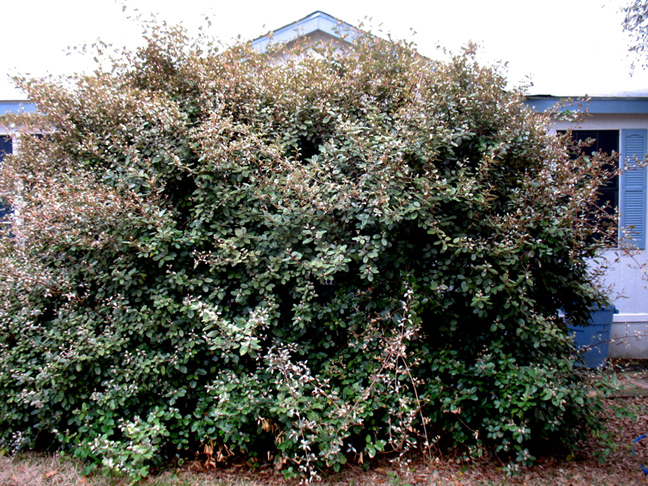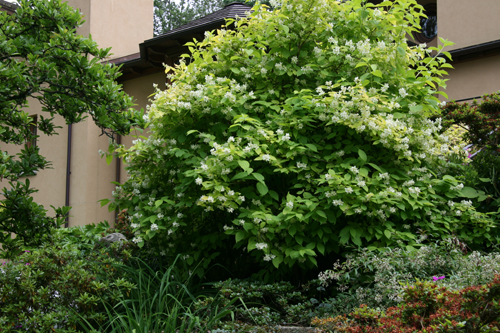It’s spring already and you’ve got a garden full of healthy trees, shrubs, perennials and vines going crazy! They need pruning to keep from taking over the neighborhood, but you heard that winter and summer are the better seasons to prune. For a seasonal overview, see our Pruning Calendar post.
But you want to know what pruning you can do right now. Does any of this sound familiar? Then you’ve come to the right place.
Now is a good time to prune shrubs that have already bloomed this year such as camellia, forsythia, dawn viburnum and some rhododendrons, as well as summer bloomers such as hydrangeas. For the rest, there is still some pruning you can do.
Most of your immediate pruning needs will likely fit into one of these two scenarios:
Your abelia shrub has branches growing into neighboring plants, onto your walkway and even over your poor dachshund (“Honey, have you seen Fritz?”)
Your magnolia tree has grown quite dense and you’d like it to look more like a tree and less like a buffalo…
Want the express version? You can make quite an improvement with just a few short steps. If you minimally head back the stragglers on the shrub-like plants, and thin out the tree-like plants so you can see through them a little better, your garden will look much tidier until summer, when you can go back and prune more substantially. Keep in mind that spring pruning tends to stimulate even faster growth, so tread lightly, especially on anything flowering.
Today, we will look at heading back and the next post will be about thinning.
Okay, let’s get started:
Part 1: Heading Back
Heading back your abelia, hedges and other shrubby friends (examples: forsythia, abelia, viburnum, lavender, yew), simply means making individual branches shorter.
Here’s the basic move: grab the tallest, longest branches which grow out of the main foliage mass, reach inside a little way, and snip ‘em off, one at a time, using hand pruners. This is called selective heading.
Sure, you could get out the scissor hedge shears or (yikes!) the electric trimmers, but do you want to make your shrub more natural looking, now and for the rest of the season? Selective heading is the better way, unless you’ve got acres and acres to trim (avoid shearing larger-leaf plants, in any case).
Work your way around the plant this way and you'll soon see a well-behaved shrub rather than an out-of-control monster. Try to keep in mind the essential branching character of the plant – are the branches upright? Horizontal? Arching? – and try to preserve that. If you reach in and snip the larger branches further back (as mentioned above), and leave the smaller ones a little longer, you can avoid the too-uniform, “sheared” look and keep that natural character. You can use loppers or a small hand-saw for thicker branches.
Remember to cut above a leaf bud or branch node, leaving as short a woody stub as is practical, to prevent a lot of "dead ends" later. This is less of an issue with vigorous or easily-sprouting shrubs (such as forsythia or rhododendron), but still a good practice.
For neighboring plants growing into each other, I suggest pruning some from each plant (rather than all from one or the other). How far back? Try to estimate how much they will grow in a year or two and give them that space. Better to have to do a little pruning more frequently than to create giant, unsightly holes that take five years to fill in! Again, lightly prune in spring; you can do more in summer.
If you find that you are cutting back overgrown plants every year, consider moving or removing some plants. They may just have grown too large for the chosen spot. This is looking at the Big Picture: the concept of Right Plant Right Place. It's better to sacrifice a plant or two for a more harmonious garden, rather than doing battle with them every year.
In most cases, you will eventually want to do some thinning on these same plants. Even hedges will be healthier in the long-term if you periodically clean out and thin them. So next I will discuss Thinning 101.
What a nice feeling to have a garden that looks well-tended, like a clean house or an organized desk. And look — you even found Fritz! A little worse for the wear and not very happy with you, but he'll get over it (go give him a treat). Now you can sit and admire your work or dive into your other spring projects.
Enjoy!





